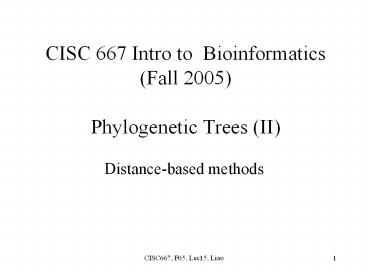CISC 667 Intro to Bioinformatics (Fall 2005) Phylogenetic Trees (II)
Title:
CISC 667 Intro to Bioinformatics (Fall 2005) Phylogenetic Trees (II)
Description:
(dim djm dij) = (dik dkm djk dkm - dik - djk ) ... ri = (1/(|L|-2)) k L dik, where L stands for the set of leaves. ... –
Number of Views:24
Avg rating:3.0/5.0
Title: CISC 667 Intro to Bioinformatics (Fall 2005) Phylogenetic Trees (II)
1
CISC 667 Intro to Bioinformatics(Fall
2005)Phylogenetic Trees (II)
- Distance-based methods
2
UPGMA unweighted pair group method using
arithmetic averages
- Distance between two clusters Ci and Cj
- dij (1/CiCj) ?p? Ci, q ? Cj dpq.
- Note it is NOT always possible to interpret
pairwise sequence similarity scores as metric
distance.
3
- Algorithm UPGMA
- Initialization
- Assign each sequence i to its own cluster Ci
- Define one leaf of T for each sequence, and place
at height zero - Iteration
- Determine the two clusters i, j for which dij is
minimal. - Define a new cluster k by Ck Ci ?Cj, and define
dkm for all m - Define a node k with daughter noes I and j, and
place it at height dij / 2. - Add k to the current clusters and remove i and j.
- Termination
- When only two clusters i, j remain, place the
root at height dij/ 2.
4
- Ultrametric for any triplet (xi, xj, xk),
distances dij, djk, dki are either all equal or
two are equal and the remaining is smaller. - Molecular clock two siblings evolve at the same
constant rate. - Such requirements are often not satisfied, and
UPGMA trees then will be not correct. - For example,
3
2
4
1
4
2
3
1
Tree reconstructed incorrectly using UPGMA
Actual tree
5
- Neighbor-joining
- Distances are additive.
- Given a pair of leaves, determine if they are
neighboring leaves (not necessarily with shortest
distance) - Once we merge a pair of neighboring leaves, how
do we compute the distance between this pair (as
a whole, called k) and another leaf, called m? - ½ (dim djm dij)
- ½ (dik dkm djk dkm - dik - djk )
- ½ (dkm dkm ) dkm.
m
i
k
j
6
- Without a tree, how can we know that if two
leaves are neighbor (when neighbors do not mean
shortest distance)? - Theorem (Saitou Nei, 1987) For each leaf i,
define ri as - ri (1/(L-2)) ?k? L dik,
- where L stands for the set of leaves.
- Then a pair of leaves i and j will be
neighboring leaves if Dij dij (ri rj) is
minimal.
7
- Example
- d12 0.3 D12 -0.9
- d13 0.5 D13 -1.2
- d14 0.6 D14 -1.1
- d23 0.6 D23 -1.1
- d24 0.5 D24 -1.2
- d34 0.9 D34 -1.1
- r1 0.7
- r2 0.7
- r3 1.0
- r4 1.0
- Neighbor joining will generate unrooted trees.
8
- Pros and Cons of distance-based methods
- Easy to implement, and fast to run
- Robust to minor sequence errors
- Distance-based phylogenetic trees do not generate
ancestral sequences - Definition of distance may be problematic































